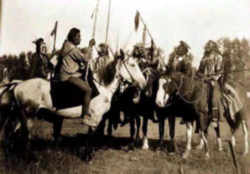


Oklahoma Symbols
Oklahoma Early History
First Early Inhabitants of Oklahoma

Early history examines the archaeological record that tells the story of the first inhabitants of Oklahoma. Learn about the prehistory and culture of the first early inhabitants, and what lessons it might teach us about the early history of Oklahoma.
Oklahoma First Early Inhabitants
- 110 Mil BP - In Oklahoma the plant eating Tenontosaurus roamed the area along with the meat-eating Deinonychus. Fossils of both together were found in 1999. (SFC, 2/23/99, p.A4)
- 110 Million - Fossils of Sauroposeidon proteles, a 60-ton, 60-foot tall dinosaur, were found in 1994 near Antlers, Okla. (SFC, 11/4/99, p.A8)
- 500-1300 AD - Spiro Indians, linked to the Aztecs, thrived and left burial mounds filled with exquisite artwork and clues to their way of life. A museum displaying their artifacts is near Spiro.
- 1012 -Viking explorers visited eastern Oklahoma and left their mark near the town of Heavener.
- AD 900-1400 - Farming and hunting people from this time in Oklahoma prehistory settled along major rivers and creeks. They planted corn, beans and squash in the fertile flood plains, hunted bison and deer, and fished and gathered mussels from the rivers. Four of these cultures have been defined in western and southern Oklahoma. Since we have no written records from this time, the names of these cultures are unknown. When early Spanish explorers came in the 1500's, they found people who called themselves the Teyas and the Escanjaques. Perhaps the people discussed here also used these names several hundred years earlier. Archeologists believe the Teyas and Escanjaques are descendants of the people discussed on these pages. They are all believed to have been Caddoan speakers.
- 1540 - Hernando de Soto (1500-1542) explores Oklahoma in search of gold
- 1541 - Francisco Vasquez de Coronado (1510-1554) explores Oklahoma
Early History of Native Americans in Oklahoma
The Indigenous People of Oklahoma
The original tribes of the area included the Apache, Arapaho, Comanche, Kiowa, Osage and the Wichita tribes. The tribes that were relocated to Oklahoma included the Arapaho, Cayuga, Cherokee, Cheyenne, Chickasaw, Choctaw, Creek, Delaware, Fox, Iowa, Kaw, Kickapoo, Miami, Otoe, Modoc, Ottawa, Pawnee, Ponca, Potawatomi, Quapaw, Sauk, Seneca, Shawnee, Wyandotte and Yuchi.
The first known inhabitants of Oklahoma were the Osage, Quapaw, Caddo, Wichita, Waco, Tawakony, Kiowa, Comanche, the Apache, and several other tribes of Indians.
Before the white man entered the region that is now the state of Oklahoma, several tribes of Indians lived in or ranged over the land. Plains Indians
including the Kiowa, Apache, Ute, and Comanche occupied the western part of the region. They were nomadic hunters who followed the huge herds of buffalo
that grazed on the grasslands.
Farther to the east, the more sedentary Wichita Indians lived in houses thatched with grass and cultivated crops such as corn, beans, pumpkins, and
melons. The Wichita are descendants of a prehistoric culture known as the Earth House People.
Of the original tribes which ranged throughout Oklahoma when Europeans first began to explore the area, only the Ute remain. A large portion of Oklahoma's
Native American population - the largest in the nation - is made up of descendants of the Cherokee, Choctaw, Chickasaw, Creek, and Seminole tribes.
These five tribes were forcibly moved to Oklahoma by the United States government between 1820 and 1842.





